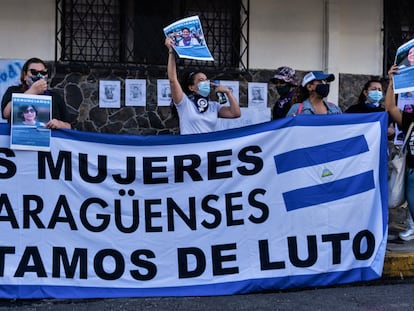Where the river meets the sea: the women who harvest shellfish
The women of the Spanish town of Cambados rake and harvest in search of clams, just as they’ve always done. But for years now, they’ve been dragging retro-futuristic carts that make their work a little easier. This is the story of how a homemade invention became a symbol of empowerment
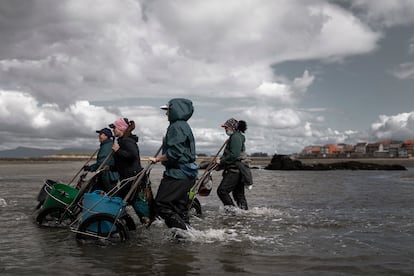
When you enter the satellite version of Google Maps and look for A Mouta beach, located in the town of Cambados, along the coast of Galicia, Spain, you’ll see a straight line that emerges from the sand, hitting the sea and then splitting into smaller lines, which resemble veins.
In reality, these are paths (well-defined in the map, despite being underwater), which lead to a place called Prado do Mar. This area is covered in vegetation, in the middle of the Arosa estuary (where water from rivers and streams mixes with salt water from the ocean) — it emerges twice a day during low tide. Stretching from there to the edge of the beach is an enormous natural shellfish nursery, buried just a few inches into the seabed when the water recedes, revealing an enormous sandbank dotted with algae, shells and squawking seagulls. This shellfish bank — called O Serrido – is the largest and most productive in Cambados.
“I can’t tell you how much space it takes up, but from the moment I enter to the time I leave, the [app] shows 12,000 steps,” says Natalia Arosa, one of the 200 shellfish collectors who follow these magical paths. She has green eyes and wears pearl earrings, a cap and a scarf. In a straight line, you can see the island of La Toja and, ahead of it, La Toja Pequeña: the other shore, which can sometimes be reached on foot. “There’s too much beach to walk,” sums up Sonia Charlín, 51, while putting on her rubber boots.
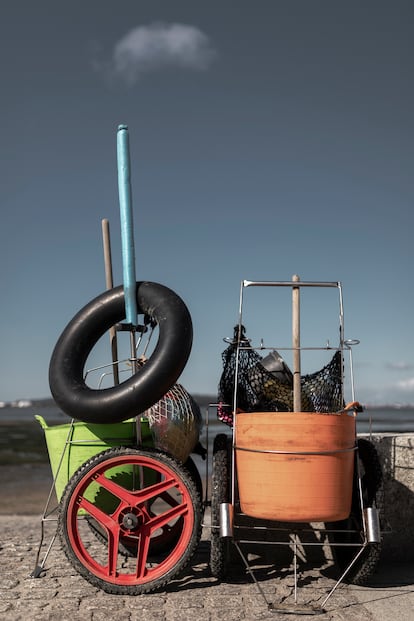
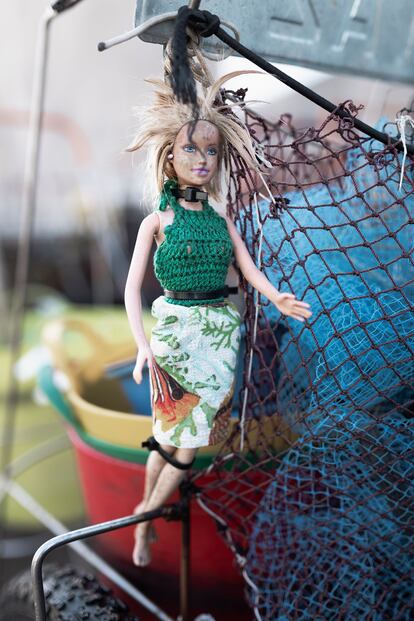
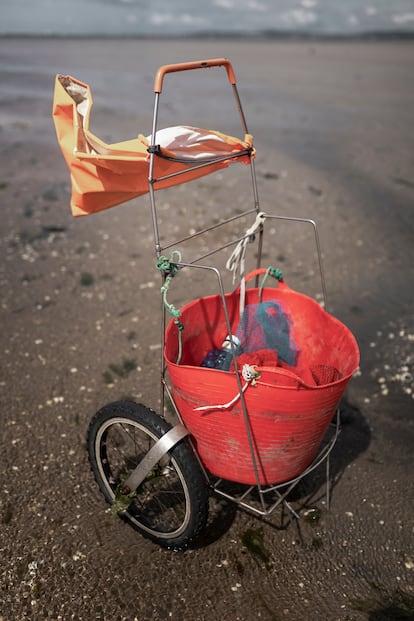
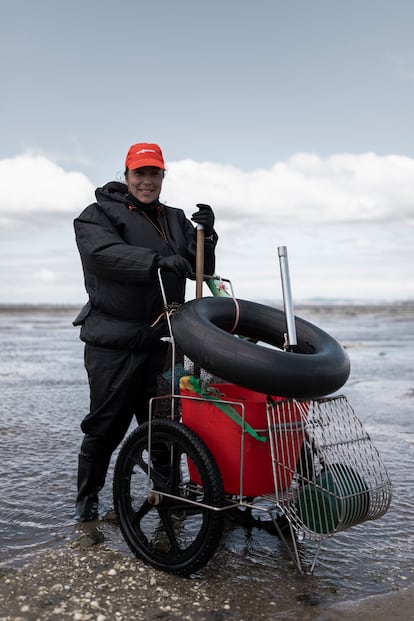
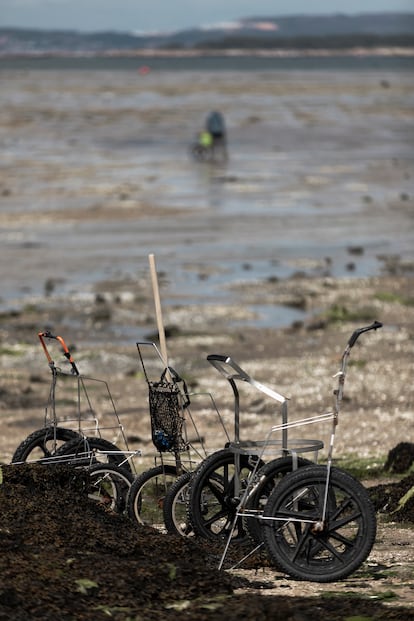

It’s 8 a.m. and dozens of women are arriving at the Cambados shellfish bank. Sonia — like the rest — prepares to go fishing. She locates the nooks and crannies of the estuary with her finger, to compare the dimensions of the work area: “[When the tide is out], it takes [two miles] to reach the wetlands. Imagine what it was like to return while carrying all the clams,” she sighs. This is why, two decades ago, around the time they began this profession, the women set an example of social and labor empowerment that is still being studied today, by devising new methods to facilitate their work. They invented something as simple as it is symbolic: a vehicle to transport material and seafood, which now goes hand-in-hand with the traditional image of the Cambados shellfish harvesters. It’s a unique steel cart, which the women look after like it’s a personal treasure.
The name “Vane” can be read on the front of one cart, with the letters welded in iron. Another, more modern, has a license plate with the name of the owner. It’s also decked out with some dolls and Christmas lights.
Elena Hermida, 59, talks about hers, which stands out among the rest: “My husband made it: he welded everything and put different wheels on it,” she recounts. Next to hers, another vehicle displays a rainbow flag made out of colorful shrimping nets. “I [use] mine with great pride,” says Pilar Serto, one of the group’s pioneers. It doesn’t appear in the history books, but they say the first cart was built by someone named José for his wife, Lola. Gradually, this design has evolved.

The cart is basically a frame with space to place the carrycot or bath, where the buckets filled with mollusks are stored (until the permitted quota is filled). It also has hooks to hang tools and, sometimes, flotation devices. This gives it the appearance of a metallic skeleton with endless appendages. There are also two striking bicycle wheels with plastic spokes. The craftsmanship — with all the materials, colors and homemade concepts — results in a kind of metal Frankenstein, while also triggering esthetic references to steampunk, a subgenre of science fiction, which includes retrofuturistic technology.
Stacked in the group’s shed, the carts look like a pile-up at the Tour de France. The shellfish collectors take them down to get them set up for the day. “We have a primitive job,” one woman laughs, “but we’ve modernized it in our own way. And I think it looks pretty.”
Until a couple of decades ago, the traditional image of this profession was that of a lady with a cloth bun in her head, wearing a shawl and apron, and carrying baskets and buckets full of shellfish. Today, it’s unthinkable.
“My grandmother [would work] barefoot. So did my mother. And now, look at me,” says Elena Hermida, equipped with waterproof clothing and boots. However, Hermida does remember those times. “That’s how we were, with flattened necks and burst cervicals,” she laments, her voice drowned out by the noise of a tractor passing by the beach. The image is telling: after all, these women were always hunched over, sowing, raking and harvesting the sea… until, just like that, a wheeled vehicle changed everything.
It occurred to someone to bring a wheelbarrow one day. It didn’t work. Others brought shopping carts, to be pulled by rope. No dice. Then came the first predecessor of the current stroller: assembled by a local ironworker, it had large bicycle wheels and steel spokes. “But of course, the tires rusted and, after a short time, [it] was no longer useful,” says Quico Noya. He’s the owner of a bicycle shop that bears his last name, in the center of Cambados, amid the smell of rubber and workshop grease. “I found [a design] that works, made of plastic, that doesn’t get eaten by rust and is the ideal size. And I fixed it,” he affirms. The wheels are from BMX dirt bikes, which are currently a rarity.
Noya subsequently contacted a tire supplier in Taiwan. He has never stopped ordering from them. First black, now other colors. Placed on the carts, these tires are reminiscent of the 1983 Australian comedy film BMX Bandits, which stars a teenage Nicole Kidman and became a cult classic among bicycle lovers in the 1980s and 1990s. Without going into detail, Noya explains that the BMX wheels need to be on the front — they take up less space and are lighter — and that, in the field of mechanics, everything can be improved. “When the tide is low, you have to disassemble [the cart] and put a stainless steel shaft in it,” he says. In Taiwan, the suppliers probably think that, in this other corner of the world, there’s a rise in BMX riders or a vintage fever… but the truth is that the new wheels are crucial for the shellfish women.

The carts are finally ready. Some — with pink or yellow carrycots to match the colorful wheels — exemplify the frugal, homemade style so common in Galicia, where bed bases are recycled as farm closures, bathtubs as cattle troughs and washing machine drums as pots. That’s why it’s not strange at all to see these devices, equipped with orange rubber bands or plastic pool rollers, which act as handles and gears. Practicality is put at the service of shellfishing.
The women move off down the forked paths, into the estuary. Some carry a long rod with a metal net that drags along the sand, while others rake the driest parts. These are the most-utilized techniques in the art of shellfishing. In this part of the coast of Galicia, clams abound: they’re raised in rafts and planted in the estuary. Each woman has a daily quota of nine pounds. However, when it comes to cockles — which are scarce, only appearing when there’s extreme dryness — they’re limited to 2.2 pounds. The process is straightforward but it wasn’t always like this.
In 1989, when shellfish gathering was unregulated, there was a dispute between shellfish collectors, who fought over a border area between Cambados and Vilanova. This ended up being resolved with the intervention of riot police, which marked the beginning of a regulatory framework. By 1999, the local council granted 220 shellfshing licenses to residents of Cambados. A license can be attained via a points system: one must have been unemployed for two years before attempting to pass two courses. It’s difficult to obtain a license… but whoever manages to get into this system doesn’t leave.

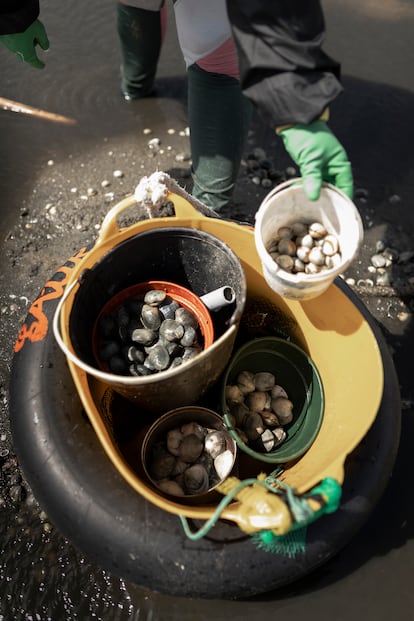
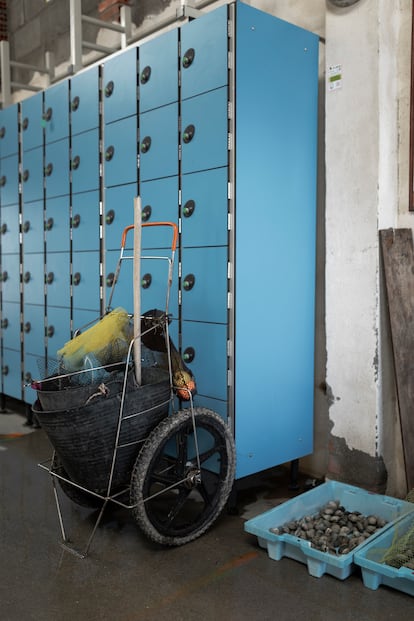
The names on the authorized list only change when someone retires or moves on due to physical problems (which are common in this line of work, despite the cart). Latin American women — as well as about 20 men — have recently joined the group. One of the men is Pablo Santos, the brother, son and grandson of shellfish women. He used to accompany them as a child to “make some money.”
“That’s how I bought a bagpipe and the tracksuit,” he laughs. Now 42, he’s been licensed for three years, since he left the construction sector, which didn’t suit him. Some of the women don’t agree with the inclusion of men in this trade. “Men do us a disservice,” Sonia Charlín emphasizes. “They’re too strong, it’s easier for them. They’re better off fishing.” Santos himself answers: “Don’t believe it, skill is more important than strength [in this business]. My mother makes more than me.”
His mother is Mari Carmen Resúa, one of the founders of the group. She’s been bending her back for 24 years, 15 days a month. “My mother used to come. Before her, my grandmother would, too. Sometimes, they sold what they caught — other times, they traded it in the village for potatoes and they made a complete meal for the family.”
Mari Carmen chats while working, listening to the splashing of the water and the clatter of the clams. The wheels of the cart glisten in the sun as she continues to rake at a steady pace. “This is a matter of patience and perseverance,” she explains. It takes about 30 rakes to get a clam. This requires lots of stretching, dragging and lumbar traction, regardless of the weather: it can be sunny, rainy, windy, it doesn’t matter.
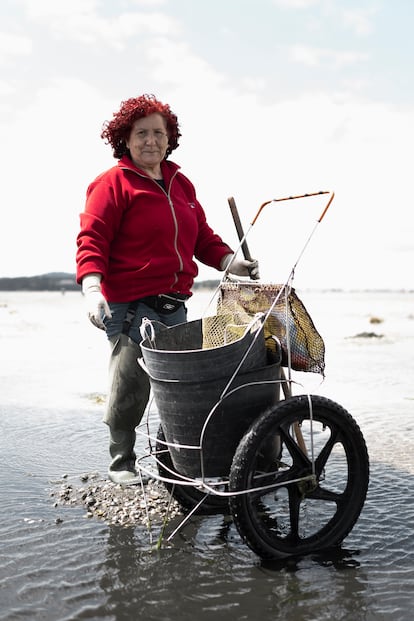
A few feet away, her daughter works, listening to music. “I put on Maluma, Daddy Yankee… so I can be on my own,” she says shyly. Nuria, 38, is one of the women who arrived to the beach after the Great Recession of 2008.
“I worked in a hairdressing shop, clothing stores. I washed cars, took care of children... at first, I was embarrassed to come here.” When asked why, she thinks for a moment. “I don’t know. I didn’t see myself here. But I had a very young daughter and she had to be supported. Then, I was out [of work] for many months due to a herniated disc. When I got better, the way I see everything changed.”
You hear this story a lot. Many of the women came to the shellfish trade after leaving behind sewing factories, or recovering from illness or injury. Their lives seem to be right out of the script for the movie Matria – a film by Spanish director Álvaro Gago, which has caused a sensation in Galicia. It’s about a woman, played by María Vázquez, who struggles to hold a job while caring for her family. She lives in an oppressive environment with little support from her partner, in the same region where the shellfish women work. In the background of the film, the viewer can see the supposed Galician matriarchy, in which women rule the estuary, while men fish or emigrate to earn a living. The film questions this independence, despite the indomitable character of the protagonist, who is so reminiscent of the shellfish women of Cambados.
The group of women — with their colorful clothes, pushing the retro-futuristic carts against the sun, with the entire weight of the region on their heads — has a fierce narrative power. They pose with fixed gazes, chins up, for a photographer who has improvised a studio next to the shed that stores the carts.
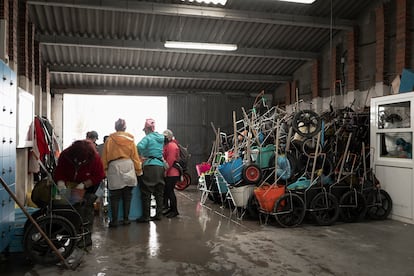
“The work is gratifying,” Sonia notes. “We work eight days a fortnight, four hours a day, [with] a gross salary of €1,200 euros ($1,300). It’s very rare that someone who enters [this profession] wants to leave. It’s a job for life.” She lists the jobs she’s had before: gardener, goldsmith, sweeper.
Shellfishing entails some extra work, as well as vigilance to prevent tourists from taking a bucket of mollusks back to their apartment. Labor regulations also involve the management of natural resources, planting and cleaning — in short, respect for the environment. The women believe that the future is sustainable in terms of harvesting clams, but they’re still concerned about climate change.
When they leave the shellfish market — after hosing down their legs — they smoke their first cigarettes in four hours. A kind of senate is assembled on a stone bench:
“Now the water is hotter than at home,” sighs 48-year-old Eva Karina. “At this temperature, the clam lacks oxygen: it comes out [of its shell] and dies,” a younger woman observes.
“And then, there’s the contamination,” a third woman says. “Last year, we got some pimples… remember how itchy they were?”
Finally, they weigh the shellfish and send off the harvest to the fish market — where they sell it without intermediaries — and go home. Hours later, in the center of Cambados, this reporter is greeted by one of the women.
“You didn’t recognize me?” she laughs. “The same thing happens to us. On the street, we don’t even recognize ourselves without our work clothes or our carts. But we’re always around.”
Sign up for our weekly newsletter to get more English-language news coverage from EL PAÍS USA Edition
Tu suscripción se está usando en otro dispositivo
¿Quieres añadir otro usuario a tu suscripción?
Si continúas leyendo en este dispositivo, no se podrá leer en el otro.
FlechaTu suscripción se está usando en otro dispositivo y solo puedes acceder a EL PAÍS desde un dispositivo a la vez.
Si quieres compartir tu cuenta, cambia tu suscripción a la modalidad Premium, así podrás añadir otro usuario. Cada uno accederá con su propia cuenta de email, lo que os permitirá personalizar vuestra experiencia en EL PAÍS.
¿Tienes una suscripción de empresa? Accede aquí para contratar más cuentas.
En el caso de no saber quién está usando tu cuenta, te recomendamos cambiar tu contraseña aquí.
Si decides continuar compartiendo tu cuenta, este mensaje se mostrará en tu dispositivo y en el de la otra persona que está usando tu cuenta de forma indefinida, afectando a tu experiencia de lectura. Puedes consultar aquí los términos y condiciones de la suscripción digital.
More information
Archived In
Últimas noticias
Most viewed
- Alain Aspect, Nobel laureate in physics: ‘Einstein was so smart that he would have had to recognize quantum entanglement’
- Mexico’s missing people crisis casts a shadow over World Cup venue
- Why oil has been at the center of Venezuela-US conflicts for decades
- Trump clarifies who is ultimately in charge in Venezuela: ‘Me’
- Mexico seeks to shore up its defenses following US incursion in Venezuela
